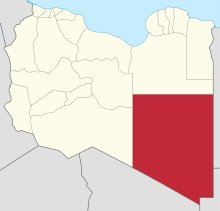Kufra District
| Kufra (الكفرة) | |
| District | |
|
Kufra in 1930
|
|
| Country | |
|---|---|
| Capital | Al Jawf |
| Area | 483,510 km2 (186,684 sq mi) |
| Population | 50,104 (2006) |
| Density | 0.1/km2 (0/sq mi) |
|
Map of Libya with Kufra district highlighted
|
|
Kufra or Kofra (Arabic: الكفرة Al Kufra), also spelled Cufra, is the largest district of Libya. Its capital is Al Jawf, one of the oases in Kufra basin. There is a very large oil refinery near the capital. In the late 15th century, Leo Africanus reported an oasis in the land of the Berdoa, visited by a caravan coming from Awjila. It is possible that this oasis was identical with either the Al Jawf or the Taiserbo oasis, and on early modern maps, the Al Kufra region was often labelled as Berdoa based on this report.
The name Kufra itself is a derivation from kafir, the Arabic term for non-Muslims. Kufra did not fall under the dominion of either the Arabs or the Ottomans and was colonized by the Arab Bedouin tribe of the Zuwayya only in the mid 19th century, and eventually by the Italians by the 1930s. In 1931, during the campaign of Cyrenaica, General Rodolfo Graziani easily conquered Kufra, considered a strategic region, leading about 3,000 soldiers from infantry and artillery, supported by about twenty bombers.
Kufra's location in Libya's southeast places it on the country's border with Egypt, Sudan (unlike any other Libyan district), and Chad. It borders the following regions of these countries, namely, New Valley Governorate, Egypt in the east, Shamaliyah State, Sudan in southeast, North Darfur State, Sudan in the far southeast, Bourkou-Ennedi-Tibesti Region, Chad in the south. Domestically, it borders the following districts, namely, Murzuq in west, Jufra in northwest and Al Wahat in north. Kufra is a part of Cyrenacian geographical subdivision, the largest region in Libya and which is mostly semi arid in nature. The region receives an annual rainfall of 5 in (130 mm). There are no perennial rivers in the region, but the region is abundant with groundwater aquifers. All three regions of the county have mostly a flat undulating plain and occasional plateau, with an average elevation of around 423 m (1,388 ft). Around 91 per cent of the land is covered by desert, with only 8.8 per cent agricultural land (with only 1 % arable lands) and 0.1 per cent of forests. It is desert climate in all other parts of the region. Dust storms lasting four to eight days is fairly common during Spring.
...
Wikipedia


